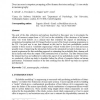Free Online Productivity Tools
i2Speak
i2Symbol
i2OCR
iTex2Img
iWeb2Print
iWeb2Shot
i2Type
iPdf2Split
iPdf2Merge
i2Bopomofo
i2Arabic
i2Style
i2Image
i2PDF
iLatex2Rtf
Sci2ools
109
click to vote
CARS
2003
2003
Does incorrect computer prompting affect human decision making? A case study in mammography
The goal of the data collection and analyses described in this paper was to investigate the effects of incorrect output from a CAD tool on the reliability of the decisions of its human users. Our work follows on a clinical trial that evaluated the impact of introducing a computerised prompting tool (R2 ImageChecker) as part of the breast screening programme in the UK. Our goal was to use data obtained in this trial to feed into probabilistic models (similar to those used in “reliability engineering”) which would allow us to find and assess possible ways of improving the interaction between the automated tool and its human user. A crucial requirement for this modelling approach is estimating the probability that a human will fail in his/her task when the output of the automated tool is incorrect. The data obtained from the clinical trial was not sufficient to inform this aspect of our probabilistic model. Therefore, we conducted a follow-up study to elucidate further the effects of...
CARS 2003 | Clinical Trial | Human User | Medical Imaging | Tool |
| Added | 31 Oct 2010 |
| Updated | 31 Oct 2010 |
| Type | Conference |
| Year | 2003 |
| Where | CARS |
| Authors | Eugenio Alberdi, Andrey Povyakalo, Lorenzo Strigini, Peter Ayton |
Comments (0)

